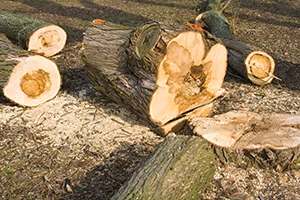
 |
When it comes to identifying and treating common tree diseases, having an arborist on staff or on call is the best way to go, says Scott Jamieson, vice president of Connecticut-based Bartlett Tree Experts. Bartlett offers a diagnostic lab for situations that need more in-depth investigation.
Healthy trees have relatively few disease problems, says J. Kelly Lewis, general manager/partner of Maryland-based Ruppert Nurseries, Inc. He believes all courses should consider annual visits and inspections by a qualified arborist. In addition to finding problems, an arborist will be aware of other problems in your area and may be able to utilize preventive treatments.
Some diseases are easiest to identify in the late summer or early fall, advises STIHL spokesperson and certified arborist Mark Chisholm. “For example, elm trees may show flagging (wilting or yellowing) or larger dying sections due to Dutch elm disease. Oak trees may be struggling with bacterial leaf scorch, and testing is best done in the late summer. Sycamore trees and dogwoods may get a leaf infection such as anthracnose that could cause health complications over time. Insects, such as spider mites, tend to increase in populations when the temperatures rise and rainfall dwindles off.”
Because of issues affecting trees in different regions of the country, make sure you consult with a local arborist who is familiar with the issues of that particular region, says Dr. Dennis Ryan, professor of arboriculture at the University of Massachusetts.
John Torsiello is a Torrington, Conn.-based writer and frequent GCI contributor.
Latest from Golf Course Industry
- Editor’s notebook: Green Start Academy 2024
- USGA focuses on inclusion, sustainability in 2024
- Greens with Envy 65: Carolina on our mind
- Five Iron Golf expands into Minnesota
- Global sports group 54 invests in Turfgrass
- Hawaii's Mauna Kea Golf Course announces reopening
- Georgia GCSA honors superintendent of the year
- Reel Turf Techs: Alex Tessman





